About Tennis elbow
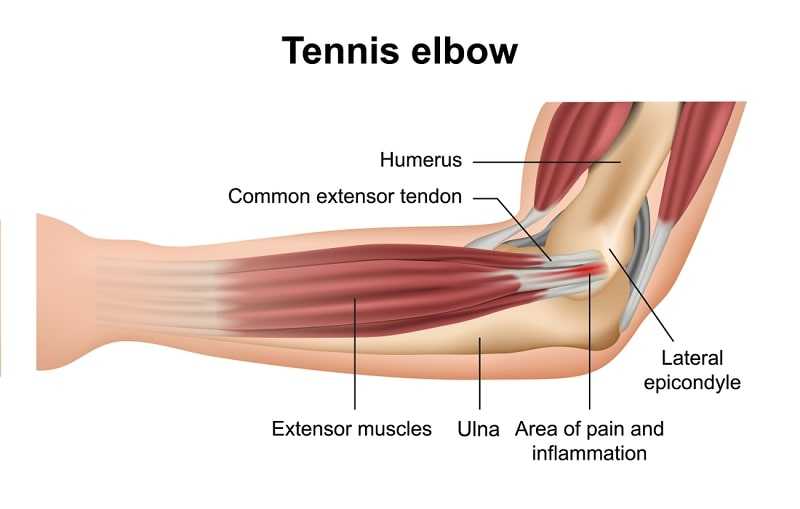
Tennis elbow, or lateral epicondylitis, is a degenerative condition of the tendon fibers that attach to the bony prominence on the outside of the elbow. The tendons involved are responsible for anchoring the muscles that extend or lift the wrist and hand as well as supinate the hand (turn the palm upward).
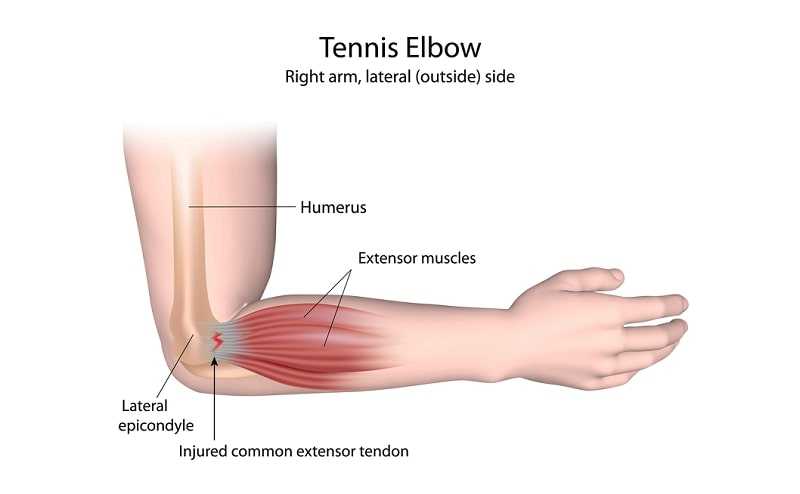
Causes
Tennis elbow is brought on by:
- Tight or weak forearm muscles
- The use of faulty arm motions in racquet sports and weightlifting
- Overuse of the elbow in sports such as tennis, racquetball, squash, or fencing
- Overuse of the elbow in activities such as meat cutting, painting, raking, or weaving
- A sudden increase in the intensity of a workout or sports activity
- Overuse of the elbow in certain professions such as plumbing, car repair, and carpentry
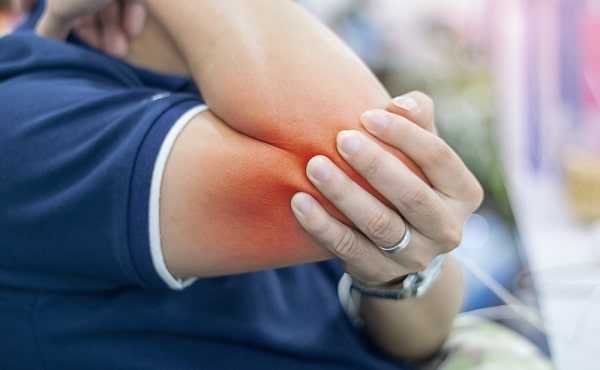
Tennis elbow happens mostly in patients between the ages of thirty and fifty, although it can occur at any age. The syndrome can affect as many as half the number of athletes who participate in racquet sports, but interestingly most patients with tennis elbow are not active in these sports. While most of the time no specific traumatic injury occurs before the symptoms arise, many individuals with tennis elbow are involved in work or recreational activities that require repetitive and vigorous use of the forearm muscles.
Symptoms
Patients often complain of severe, burning pain on the outer part of the elbow. In most cases, the pain is rather mild at first but gradually increases over weeks to months. The pain can be made worse by performing a backhand stroke in racquet sports, golfing, turning a doorknob, weightlifting, pressing on the outer part of the elbow, or gripping or lifting objects, especially with the palm facing down. Even lifting light objects such as a book or a cup of coffee can cause significant discomfort. In more severe cases, pain can occur with simple movement of the elbow and radiate to the forearm.
Diagnosis
Your doctor may press on various parts of your elbow and ask you to lift your wrist or fingers against resistance to see whether your lateral epicondyle is injured. X-rays are usually not necessary to diagnose tennis elbow. Rarely MRI scans may be used to show changes in the tendon where it attaches to bone.
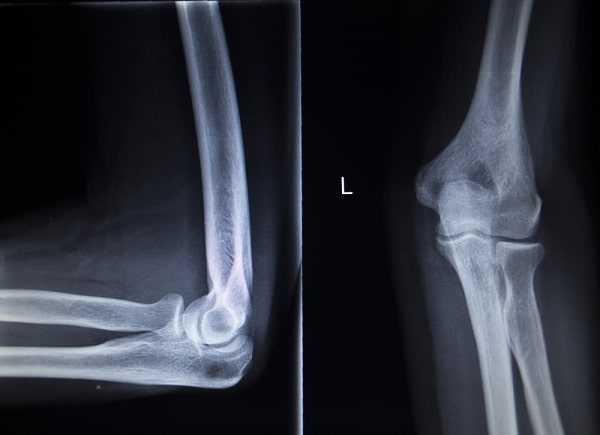
Nonsurgical Treatments
Treatment of tennis elbow involves rest and avoiding those activities that worsen your pain. The use of counterforce straps can help with symptoms; these rest the muscles and tendons of your elbow and should provide significant pain relief within four to six weeks.
In mild cases of tennis elbow, nonsteroidal anti-inflammatory agents may be helpful. Injection of corticosteroids and a local anesthetic into the painful area may also be of assistance in cases that don’t respond to conservative therapy, although an excessive number of injections should be avoided due to possible local and systemic side effects of steroids. Your physician may recommend physical therapy, which would probably involve stretching and range-of-motion exercises, as well as gradual strengthening of the affected muscles and tendons. Thankfully, nonoperative treatment is successful in as many as 90 percent of tennis elbow cases.
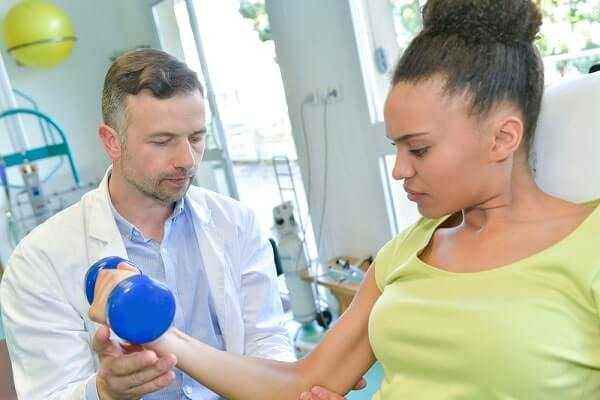
After the pain has resolved, a daily physical therapy program involving stretching of the tendons may be helpful. Consulting a professional about your playing technique and the grip size on your racket may also prevent recurrence.
A new treatment called extracorporeal shock wave therapy (ESWT) is also being applied to tennis elbow in some clinics, although its use is somewhat controversial. The treatment uses sound waves to cause tissues to experience microtrauma, which is thought to initiate a healing response and help decrease the inflammation that characterizes tennis elbow. Shock waves are also used in the treatment of heel spurs and kneecap tendonitis. If you are diagnosed with tennis elbow, you may want to ask your doctor whether this new therapy might provide some relief.
Surgical Treatments
Surgery is considered only for those patients who have incapacitating pain that does not respond to nonoperative therapy. Surgery for tennis elbow involves removing diseased tendon tissue and reattaching normal tendon tissue to bone. The surgery is usually performed through a small incision over the bony prominence of the outer elbow, although some centers are now performing this outpatient procedure through an arthroscope. A splint is placed on the elbow for a week, after which exercises to stretch the elbow and restore range of motion are started. Strengthening exercises are begun gradually two months after surgery, and most people can resume their athletic activity within four to six months. Tennis elbow surgery is successful for approximately 90 percent of patients.
Exercises for Prevention and Healing
Many of the muscles and tendons that become overused and cause tennis elbow can be trained to be more flexible and thus resistant to trauma. The following exercises are designed to give you ways to stretch, warm up, and strengthen these parts of the elbow:
Backhand Stretch – Hold your arm out in front of you, keeping your elbow straight and the palm of your palm face down. Reach with your other hand and press the back of your extended hand gently downward until you feel a stretch on the back of your forearm. Hold for ten seconds and release.
Forehand Stretch– Hold your arm out in front of you, keeping your elbow straight and the palm of your hand face down. With your other hand lift the fingertips of your extended hand slowly up and back until you feel a gentle stretch along the palm side of your wrist and forearm. Hold for ten seconds and release.
Backhand Lift – Sit with your injured elbow relaxed and bent at 90 degrees with the palm down on your thigh. Slowly bend your wrist upward as far as you can without causing pain. Hold for two counts, then slowly lower back to the original position. Add a maximum of one pound of weight (held in the palm of your hand) if you can do this exercise completely without pain.
Wrist Rotation – Sit with your injured elbow bent at 90 degrees and your hand resting palm up on your knee. Hold a one to two pound weight in your hand. Slowly rotate your palm down, and then up, lifting the weight slightly above your knee.
“thumb’s up.” – Sit with your injured elbow straight, hand resting on your knee and your thumb pointing up. Slowly bend your wrist up as far as possible without lifting it. Hold for two counts, then slowly lower your wrist and relax. You can try adding up to one pound of weight, as long as you do not experience any pain.





